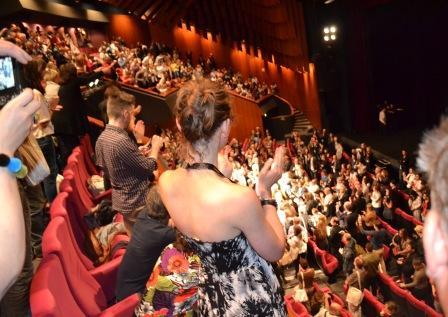Wim Wenders and Juliano Ribeiro Salgado teamed up together to make Salt of the Earth, a documentary tribute to Sebastião Salgado, the renowned Brazilian photographer who spent 40 years "photographing the human condition," and wildlife, in over 30 countries around the world. The film, which premiered this evening at Cannes, is a series of stunning photographs, all Salgado's, and video footage, including brief interviews with Salgado's wife and son, co-director Juliano, basically following the chronology of the photographer's projects. The voice-over is Salgado's own voice, alternating with that of Wenders.
It is the most gripping movie I have seen yet in the Cannes festival this year. What makes it outstanding is Salgado. The man began as an economist, with a promising career in the World Bank, but while on a business trip in Africa for his job, he took some photos of the area and when he came back he decided to quit economics and devote his life to photography. He and his wife Lélia invested in camera equipment, moved to Paris... and the two launched his career.
It is a risk that paid off, and led to darker and darker places, as Salgado's gaze turned to the subjects that fascinated him, from conflict areas such as the Bosnian war to the "workers building our planet" to the "spectacle" of the 100 oil rigs lit up by Saddam Hussein during the Kuwait War. Each image stuns: the crazed thoroughbred horses entrapped behind a wall while the oil rigs blaze; the walruses fighting each other in the Arctic, with jutting tusks; the cadavers being bulldozed into a ditch, with a woman's thin arm sticking up; the three tiny triplets lying on a blanket, one of them, with glazed eyes, already dying. The original music by Laurent Petitgand underscores the stunning effect.
For the point that Wenders' film brings home is that there is beauty in these images, a beauty that comes from the photographer himself: his tremendous empathy "for all human life". In a voice-over, Salgado tells us that he would often put down his camera and cry. In fact, after his trip photographing the genocide in Rwanda, he felt he would put down his camera for good. "The human being is a cruel animal," he reports. "I no longer believed in anything."
But then he turned to wildlife. We see photo after photo of animals: thousands of black penguins standing in the ice, as far as the eye can see; an aged turtle from Galapagos; an iguana's claw, scaled, the photographer tells us, like a medieval knight's armor.
This passion for the natural leads the photographer back to the earth, and, eventually, back to his native land in Minas Gerais, Brazil. Salgado puts down his camera and picks up the spade. What he achieves in his latest project: the reforestation of over a million trees, "a gift back to the planet".
"Life is a full cycle," Salgado comments soberly, now seventy, the enthusiasm in his limpid eyes unchanged since we first saw him as a passionate young man. He is--the film makes clear--a role model of a human being for all of us: a man undeterred in his creative vision and his commitment to the planet.
The crowd at the Cannes premiere spontaneously stood up and clapped furiously, as Wenders and Salgado (the son) stood up after the screening with their team.


